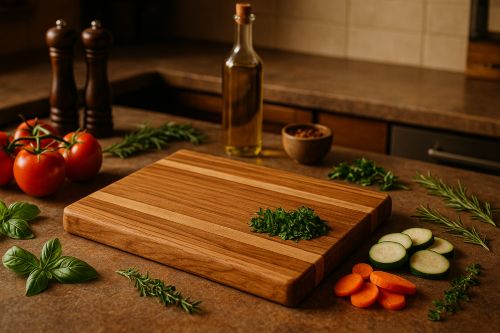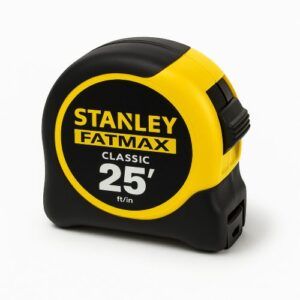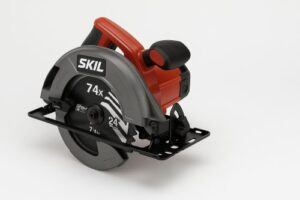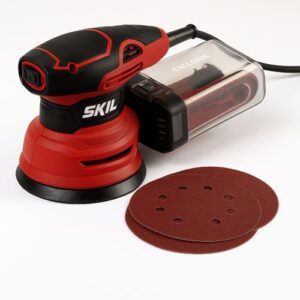Building your own wooden cutting board is one of the easiest and most rewarding woodworking projects you can take on.
It’s quick, beginner-friendly, and leaves you with a beautiful piece you’ll end up using every single day in your kitchen.
In this guide, I’ll walk you through everything you need to know —
Selecting the right hardwood,
Making clean, accurate cuts,
Sanding it silky smooth,
And finishing it with food-safe oil for that pro-level shine.
Whether you’re brand new to woodworking or just want a simple weekend build,
this cutting board project is the perfect place to start.

🔧 Tools You’ll Need
1. Tape Measure
A reliable tape measure ensures your cutting board dimensions stay accurate and square.
A good one makes layout easy and keeps all your sides lined up perfectly.
💡 Great for quick layout, consistent sizing, and double-checking symmetry.
🌟 Amazon Product Suggestion:
✔️ STANLEY FATMAX 25-Foot Tape Measure
A tough, reliable tape measure built for real job-site use. The STANLEY FATMAX 25′ delivers crisp easy-read markings, a strong standout, and the perfect length for woodworking and outdoor projects.
Why it’s great:
✔️ Heavy-duty, long-lasting construction
✔️ Easy-read numbers for quick measuring
✔️ 25-foot length covers indoor and outdoor builds
✔️ Smooth standout for measuring long boards solo
✔️ Trusted brand with thousands of great reviews
2. Skil Saw
A Skil Saw (circular saw) gives you the clean, straight cuts you need to break down your board to size.
It’s fast, efficient, and perfect for cutting hardwood planks used in cutting boards.
💡 Ideal for ripping and crosscutting boards with precision.
🌟 Amazon Product Suggestion:
✔️ SKIL 15-Amp 7-1/4″ Circular Saw
(5280-01)
This SKIL saw is a solid, no-nonsense workhorse for cutting lumber.
The 15-amp motor gives you smooth, confident cuts, and the built-in laser helps keep your lines straight. It’s lightweight, easy to handle, and perfect for breaking down boards for a project like this porch bench.
Why It’s Great:
✔️Strong 15-amp motor
✔️Laser guide for straight cuts
✔️Lightweight and beginner-friendly
✔️Great for rip cuts and crosscuts
✔️Excellent value for the price
3. Sander
Sanding is where your board starts looking like something you’d proudly set in your kitchen.
A quality orbital sander smooths edges, rounds corners, and preps the surface for a silky mineral-oil finish.
💡 Crucial for smoothing, softening edges, and getting that professional feel.
🌟 Amazon Product Suggestion:
✔️ SKIL 5” Random Orbital Sander
(with Cyclonic Dust Box)
This SKIL 5” random-orbital sander is a killer little powerhouse — perfect for smoothing out your walnut display case, taking down glue squeeze-out, or prepping panels before finishing.
It’s compact, strong, and stupid-easy to control.
The built-in cyclonic dust box actually works (rare for budget sanders),
keeping the air cleaner while you work.
Why It’s Great:
✔️Great for fairing large curved surfaces
✔️Fast stock removal with fine finish capability
✔️Ideal for sanding epoxy and smoothing planks
✔️A reliable tool for all final shaping work
⭐ Why This Project Is Perfect For Beginners
Making a wooden cutting board teaches you the fundamentals —
measuring, cutting, smoothing, and finishing —
without complicated joinery or expensive tools.
It’s a great confidence booster, uses minimal material,
and gives you a finished product you can be proud of.
Plus, you can customize the size, shape, and wood type to match your kitchen.
🪵 Step-By-Step: How To Make A Wooden Cutting Board
STEP 1 — Select Your Wood
Choose a hardwood such as maple, walnut, cherry, or beech.
These woods are durable, food-safe, and sand beautifully.
👉👉 Pro Tip: Hardwoods last longer than softwoods and resist knife marks much better.
STEP 2 — Measure Your Cutting Board Dimensions
Decide on your size—most boards fall between 10″×14″ or 12″×18″.
Use your tape measure to mark clean, accurate layout lines.
👉👉 Pro Tip: Draw your guidelines on painter’s tape to reduce pencil marks on the wood.
STEP 3 — Make Your Cuts With The Skil Saw
Clamp your board down and cut along your layout lines using your Skil Saw for clean, straight edges.
👉👉 Pro Tip: Use a sharp, fine-tooth blade to minimize tear-out on hardwood.
STEP 4 — Square Up The Edges
Lightly sand or plane the edges to remove saw marks and ensure the board sits flat and square.
👉👉 Pro Tip: A quick pass with 120-grit on the edges can make a big difference.
STEP 5 — Round Over The Corners (Optional)
Use a sander or sanding block to slightly round the corners for comfort and a polished look.
👉👉 Pro Tip: A soft radius makes the board easier to handle and looks more professional.
STEP 6 — Sand The Entire Surface
Start with 80-grit, then move to 120-grit, and finish with 220-grit until your board feels smooth all over.
👉👉 Pro Tip: Sand with the grain only — never across it.
STEP 7 — Break The Edges
Run a quick bevel or soft round-over along all the edges to remove sharp corners.
👉👉 Pro Tip: Edges that are too sharp will splinter over time — soften them for longevity.
STEP 8 — Clean The Board
Use a damp cloth to wipe off sanding dust. Let the wood dry completely before finishing.
👉👉 Pro Tip: A slightly damp wipe also raises the grain, making your final sanding smoother.
STEP 9 — Apply Food-Safe Finish
Use mineral oil or cutting board conditioner. Apply generously and let it soak in.
👉👉 Pro Tip: Apply multiple coats until the board stops absorbing oil.
STEP 10 — Final Buff & Shine
Buff your board using a clean cloth to bring out the natural color and beauty of the wood.
👉👉 Pro Tip: Monthly oiling keeps your cutting board looking brand-new for years.
🧠 Final Thoughts…
Making your own wooden cutting board is a simple way to sharpen your woodworking skills while creating something useful and beautiful.
With just a few tools and a single board of hardwood, you can craft a kitchen essential that’ll last a lifetime.
Once you build one, you’ll probably end up making them as gifts too —
Everyone loves a handmade cutting board.
🪵 More Woodworking Projects You’ll Love
If you’re looking for your next build, here are a few reader favorites from SawdustSmarty:
Craft it. Shape it. Own it!
🧰 Need More Woodworking Plans?
👉👉 Click here to learn more about Ted’s Woodworking Plans:
If you want hundreds of additional project ideas with clear step-by-step instructions, my full review breaks down exactly what you get inside Ted’s Woodworking Plans.
It’s a great resource if you like weekend builds, simple jigs, or classic shop projects.
Check out the full review here → Ted’s Woodworking Plans
💡 Turn Your Woodworking Passion Into Income
👉👉 Click here to learn more about Wealthy Affiliate
SawdustSmarty started as a simple hobby.
It grew because I finally learned how to build a real website — the right way. If you’ve ever thought about turning woodworking into a side business or income stream, Wealthy Affiliate is the training I personally recommend.
Click here to read more → Wealthy Affiliate






